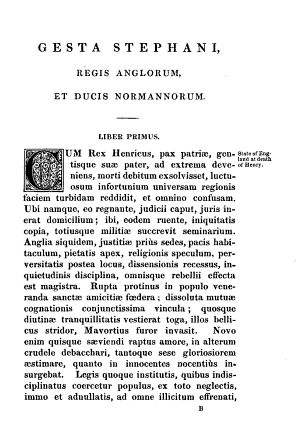Gesta Stephani facts for kids
The Deeds of King Stephen, also known as Gesta Stephani, is an important book from the middle of the 1100s. It tells the story of King Stephen of England and his fights with his cousin, Empress Matilda. This time was called "the Anarchy" because there was a lot of chaos and fighting in England. The book was written by someone whose name we don't know, but some historians think it might have been Robert of Bath, who was a bishop.
The Gesta Stephani is one of the main sources that helps us understand this period in English history. It was first printed in Paris in 1619. That first copy came from a handwritten book (called a manuscript) that is now lost. Later, a more complete manuscript was found in Valenciennes, France, and it has also been published. The Latin text of the book has 120 chapters and describes the difficult time during King Stephen's rule, ending when King Henry II became king.
Who Wrote the Gesta Stephani?
The Gesta Stephani was written in two main parts. Historian R.H.C. Davis believes the first part, covering the first twelve years of Stephen's rule, was written around 1148. The second part, which goes up to Henry II becoming king, was likely written after 1153.
Davis studied the places mentioned in the book. He found that most of them were in the South-West of England. The book gives very detailed descriptions of Bristol and Bath. It also makes some critical comments about Bristol. This suggests the writer might have lived or worked near Bath.
The person who wrote the Gesta is not known for sure. Historians agree that the author was not from a monastery. The writer traveled a lot, as shown by his knowledge of places like Exeter, London, Pevensey, and Bedford. However, he didn't know much about the North or East of England. He also focused a lot on less important noble families from the South-West.
The writer was likely a scholar. He often left out dates and small details to make the story flow better. He also used old Roman terms for jobs instead of the common words used in the Middle Ages. Many experts believe the author supported Henry of Blois, who was the Bishop of Winchester. Some historians, like Davis, think the writer might have been Robert of Lewes, who was the Bishop of Bath.
The Manuscripts of Gesta Stephani
Two handwritten copies, or manuscripts, of the Gesta Stephani have been known to experts. However, one of them is now lost.
The first manuscript was kept in a church library in Laon, France. It was printed in the 1600s but later disappeared. This copy only went up to the year 1147. It was also damaged, with some pages hard to read and parts of the text missing.
The second manuscript was found in the Municipal Library at Valenciennes, France. This copy originally came from the Abbey of Vicoigne. It contains all the information from the first manuscript. Plus, it continues the story until the very end of Stephen's rule. This second manuscript is also clear and easy to read where the first one was damaged. It has the same four missing parts as the first manuscript. This makes some experts think that the second manuscript was copied from the first one.
How the Book Was Published
A manuscript of the Gesta Stephani was found in the libraries of the bishop of Laon in the early 1600s. It was first printed in 1619 in Paris by a French historian named André Duchesne. This first printed version was not complete, and the original manuscript was lost after Duchesne's death.
This text was later reprinted in England by R.C. Sewell in 1846 and by Richard Howlett in 1886. Howlett's version was praised for being better than Duchesne's and for its helpful introduction. The book has been translated into English twice. The first translation was by Thomas Forester in 1853, and the second was by Joseph Stevenson in 1858.
A new manuscript was found in the Municipal Library, Valenciennes, by Professor R.A.B. Mynors. He found it with another historical text. This new manuscript continued the history of Stephen's reign up to 1154. It also filled in the damaged parts that Duchesne could not read. In 1955, this new version was translated by K.R. Potter and published. It was reprinted in 1976 and included a new introduction by R.H.C. Davis.
See also


